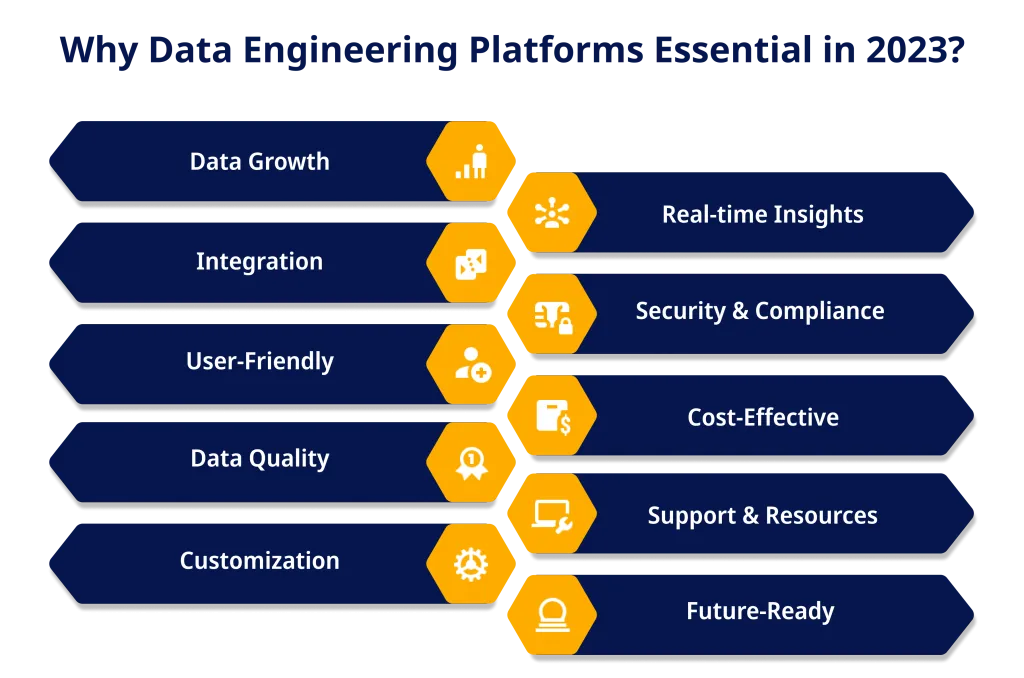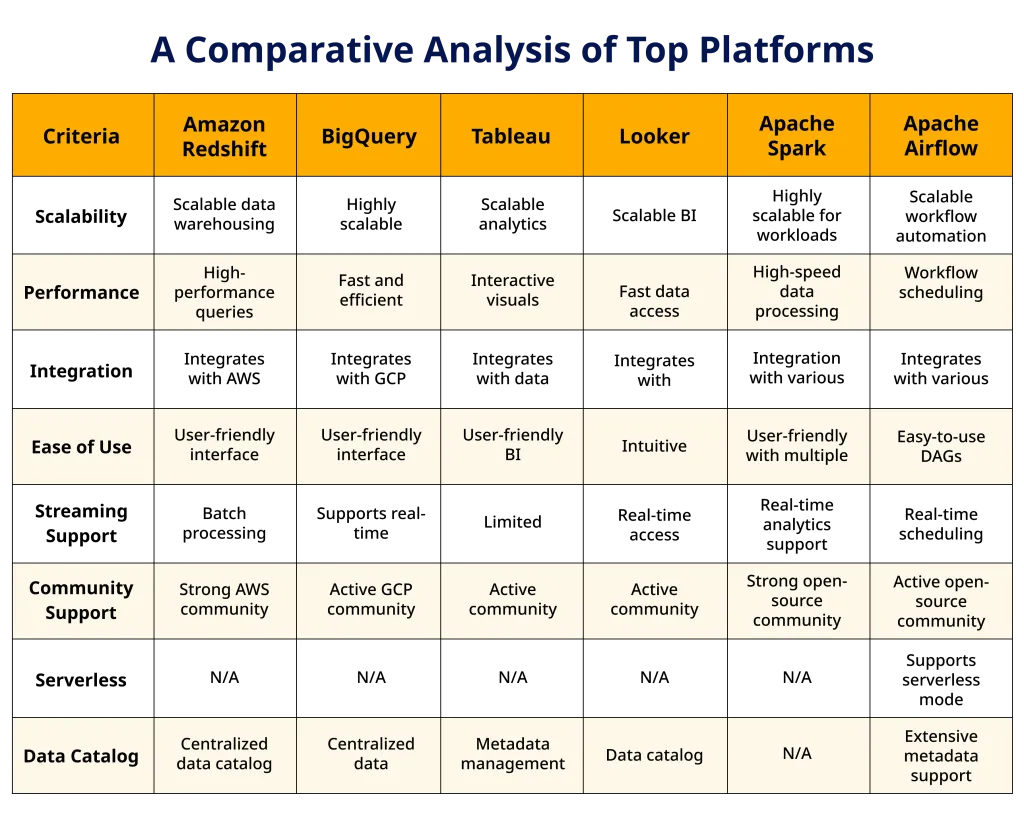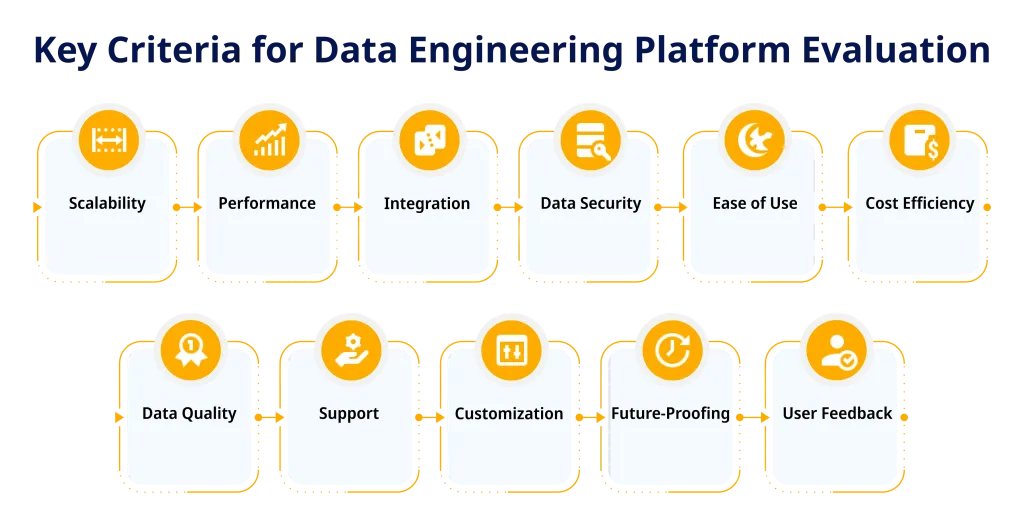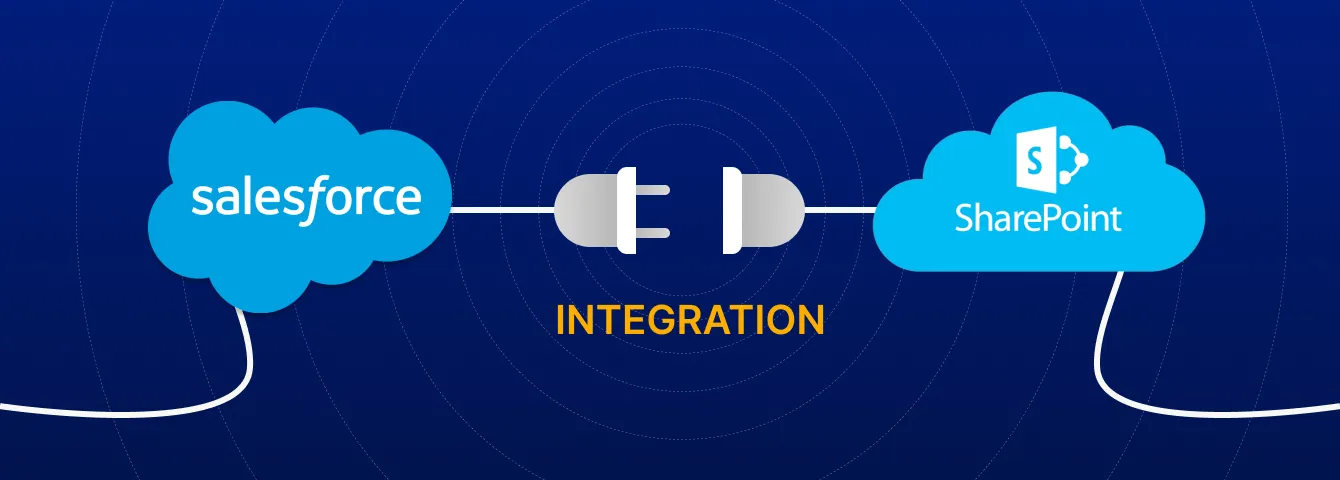Data is the lifeblood of modern business. But making sense of exploding data volumes needs strong infrastructure to intake, process, and analyze information efficiently.
Data engineering platforms provide these essential capabilities to manage data at scale and power analytics efforts.
But with a wide range of options, selecting the right platform is no simple feat.
Should you bet on cloud-native services or on-premise enterprise tools?
Leverage open-source Spark or commercial solutions?
The Big Data Engineering Services market size is estimated to grow from USD 68.76 billion in 2023 to USD 140.60 billion by 2028, at a CAGR of 15.38% during the forecast period (2023-2028).
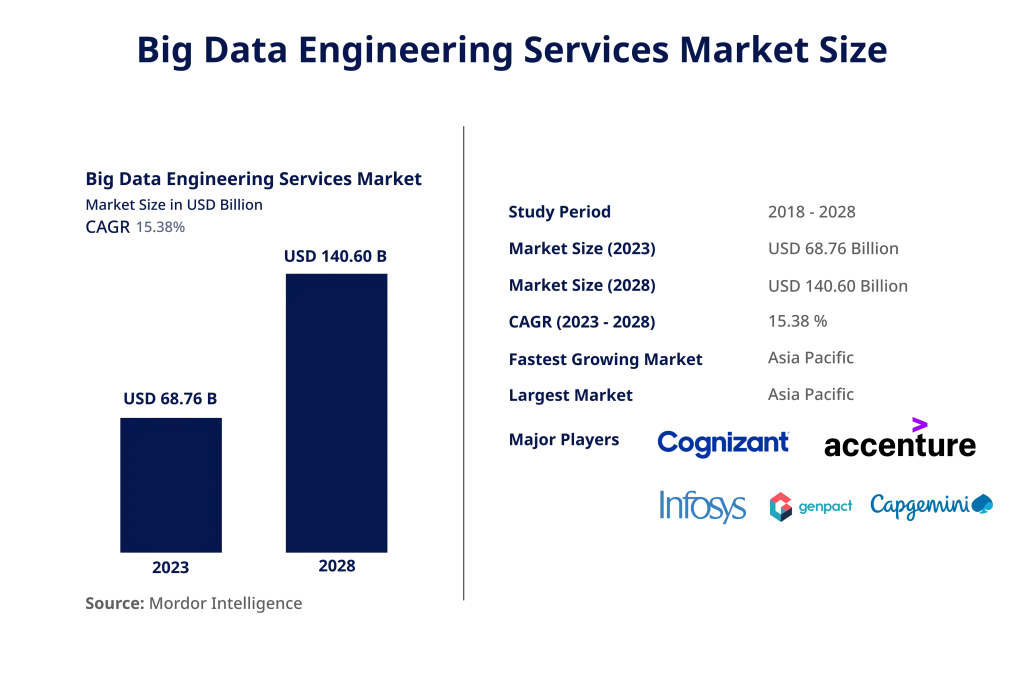
With so much potential value at stake, choosing the right technology is critical.
In this comprehensive analysis, we cut through the promotional noise to benchmark leading data engineering platforms objectively.
Explore core capabilities like data processing and emerging features like ML pipelines and governance to find today’s top contenders.
Let’s examine the complex tradeoffs, often-overlooked facts and key decision factors that you need to future-proof your data infrastructure.
The Need For Data Engineering Platforms in 2024
Data engineering platforms are the backbone of modern data management. They encompass tools and services designed to collect, process, and transform raw data into valuable insights.
These platforms enable organizations to efficiently handle large volumes of data, making them an integral part of any data-driven strategy.
Compare pricing models to choose the most cost-effective solution.
To harness the power of data effectively, businesses must invest in cutting-edge data engineering platforms. Here’s why:
- Data Ingestion: Data engineering platforms excel at gathering data from diverse sources. They provide the pipelines necessary to acquire data from databases, APIs, IoT devices, and more.
- Real-time Insights: Another reason timeliness, which is crucial in decision-making. Modern platforms enable real-time data processing, allowing organizations to glean insights instantly, respond to market changes, and personalize customer experiences.
- Data Transformation: Raw data rarely arrives in the format we need. These platforms offer powerful transformation capabilities, allowing you to clean, enrich, and structure data according to your requirements.
- Cost Efficiency: Managing data infrastructure can be costly and resource-intensive. But data engineering platforms optimize resource utilization, reducing operational expenses while maintaining high performance.
- Scalability: In the data world, growth is inevitable. Data engineering platforms are built to scale horizontally and vertically, accommodating data growth effortlessly.
- Reliability: Reliability is non-negotiable when it comes to data. However, data engineering platforms ensure data consistency and uptime, which are critical for real-time analytics and decision-making.
- Integration: Seamless integration with other data tools, such as data visualization services and business intelligence (BI) services, is a hallmark of data engineering platforms.
- Expert Data Engineers: These platforms are the playground for expert data engineers. They offer a range of programming languages and frameworks, empowering engineers to implement custom solutions.
- Future of Data Engineering: As data engineering evolves, so do these platforms. They anticipate and adapt to emerging trends, such as AI integration and real-time data processing, keeping your data infrastructure future-proof. AI in data engineering tools 2024 can help business unlock their full potential by supporting them with process and manage data better.
Also Read: Future With IoT
Top Data Engineering Platforms: Comparative Analysis
Now, let’s evaluate and compare some of the top data engineering platforms of 2024.
1. Amazon Redshift
Amazon Redshift is a robust, fully managed, and scalable data warehousing solution offered by Amazon Web Services (AWS).
It’s designed to handle vast amounts of data and deliver high-performance analytics. Here are some key highlights:
- Scalability: It uses columnar storage to optimize query performance even as your dataset expands.
- Performance: It provides fast and efficient queries, making it suitable for complex analytical workloads.
- Integration: Seamlessly integrates with other AWS services and tools, enhancing its compatibility within the AWS ecosystem.
- User-Friendly: Offers an intuitive management console for easy cluster setup and monitoring. It supports standard SQL, making it accessible to SQL users.
- Serverless: With Redshift Spectrum and Redshift Data Lake Export features, you can extend your data warehousing capabilities and query data without loading it into Redshift.
Explore cutting-edge data engineering for unmatched business growth.
2. BigQuery
BigQuery, offered by Google Cloud Platform, is a cloud-native, serverless, and highly scalable data warehouse designed for high-performance data analytics. Here are some key aspects to consider:
- Scalability: BigQuery is known for its scalability, seamlessly handling massive datasets, and providing fast query performance, making it ideal for data engineering trends.
- Serverless: With BigQuery, there’s no need to manage infrastructure. It automatically handles resource provisioning and scaling, allowing you to focus on analysis.
- Real-time Data Processing: It supports real-time data ingestion and analysis, which aligns well with modern data processing solutions.
- Integration: BigQuery integrates with various data sources, including Google Cloud storage, and supports SQL queries for data analysis.
- Cost-Efficiency: Pricing is based on the amount of data processed, making it cost-effective for businesses of all sizes.
3. Tableau
Tableau is a renowned data visualization and business intelligence tool known for its user-friendly interface and powerful analytics capabilities.
Here’s a concise overview of its key features:
- Intuitive Visualizations: Tableau enables users to create stunning, interactive visualizations, making them accessible to technical and non-technical users.
- Data Connectivity: It seamlessly connects to a wide range of data sources, including databases, spreadsheets, cloud platforms, and more, enhancing its utility in data engineering tools in 2024.
- AI Integration: Tableau incorporates AI-driven features for data analysis, prediction, and automation, keeping it aligned with AI in data engineering trends.
- Real-time Analytics: Users can perform real-time data analysis and generate live dashboards, ensuring that insights are up to the minute.
- Community and Support: A vibrant user community and ample online resources contribute to Tableau’s user-friendliness and troubleshooting capabilities.
4. Looker
Looker is a data exploration and analytics platform that stands out for its intuitive interface and powerful data modeling capabilities, aligning it with the evolving trends in data engineering tools for 2024:
- Data Modeling Excellence: Looker offers robust data modeling, providing a unified and consistent view of your data across the organization, a critical feature in the context of data engineering tools in 2024.
- User-Friendly: With a user-friendly interface, Looker empowers technical and non-technical users to perform sophisticated data analysis, create customized reports, and build interactive dashboards.
- AI-Enhanced Insights: Looker leverages AI and machine learning to help users uncover actionable insights from their data, making it a relevant player in the AI data engineering landscape.
- Real-Time Data Access: It enables users to access and analyze data in real-time, ensuring that decisions are based on the most up-to-date information.
- Seamless Integrations: Looker seamlessly integrates with a wide range of data sources and popular data warehousing solutions, providing flexibility in data connectivity.
5. Apache Spark
Apache Spark is a versatile and high-performance data processing framework that excels in handling large-scale data analytics services. Here are key highlights:
- Speed and Performance: Spark is renowned for its speed in processing large datasets, making it an excellent choice for data analytics services. It can perform batch processing and real-time streaming analytics swiftly.
- Ease of Use: Spark offers APIs in multiple programming languages, including Java, Python, and Scala, making it accessible to many software developers and data analysts.
- Versatility: It supports various data processing tasks, including batch processing, machine learning, graph processing, and real-time data streaming, providing flexibility for different analytics needs.
- In-Memory Processing: Spark leverages in-memory computing, reducing data read/write times and enhancing processing speed.
- Community and Ecosystem: It boasts a vibrant open-source community and a rich ecosystem of libraries and tools, ensuring robust support for various data analytics services.
- Scalability: Spark scales horizontally, handling increasing data volumes and growing workloads.
6. Airflow
Apache Airflow is an open-source platform for orchestrating, scheduling and monitoring workflows.
It is crucial in automating tasks and data pipelines, making it valuable for various use cases, including Business Intelligence (BI) services. Here are key aspects to consider:
- Workflow Automation: Airflow lets you define, schedule, and automate workflows through code, ensuring tasks run efficiently and reliably.
- Flexibility: It offers a flexible and extensible framework, enabling users to create custom workflows and integrate with various data sources and BI services.
- Monitoring and Logging: Airflow provides a centralized dashboard for monitoring task execution and logs, facilitating troubleshooting and performance optimization.
- Community and Integrations: Airflow benefits from an active open-source community, offering many integrations and extensions.
- DAGs (Directed Acyclic Graphs): Workflows in Airflow are defined as DAGs, allowing users to model complex dependencies and conditional logic
Also Read: Top BI Implementation Services
Making the Right Choice
Here are some key considerations to guide your decision-making process while finalizing a data science development company platform:
- Define Your Needs: Define your organization’s data engineering requirements precisely. Understand your data volume, complexity, and real-time data processing needs.
- Evaluate AI Integration: Assess how AI in data engineering can benefit your operations. Explore if the platform offers AI-driven data transformation, predictive analytics, or automation capabilities.
- Consider Data Engineering Tools 2024: Stay updated on the latest data engineering tools in 2024. Ensure that your chosen platform aligns with current industry trends and technological advancements.
- Scalability and Performance: Check if the platform can scale to accommodate your growing data volumes while maintaining high-performance levels. Evaluate its real-time data processing capabilities.
- Integration and Compatibility: Examine how well the platform integrates with your existing systems, databases, and analytics tools. Compatibility is crucial for seamless data flow.
- Data Security and Compliance: Prioritize data security and compliance features. Ensure the platform meets your organization’s data protection needs and adheres to relevant regulations.
- Cost Efficiency: Analyze the total cost of ownership, including licensing fees, hardware, and ongoing operational expenses.
- User-Friendliness: Consider the ease of use for your team. A user-friendly interface and intuitive tools can boost productivity and reduce training time.
- Support and Documentation: Investigate the availability of customer support, documentation, and a user community.
- Future-Proofing: Look at the platform’s roadmap and how it aligns with the future of data engineering. Ensure it can adapt to emerging technologies and trends.
Also Read: 5 Web Application Security Best Practices
Future Outlook
Here, we look into some of the prominent trends shaping the landscape:
- DataOps and MLOps Integration: DataOps and MLOps, designed to enhance collaboration and automation in data and machine learning workflows, are converging. This integration streamlines the development and deployment of data-centric applications.
- Cloud-Native Data Engineering: The shift towards cloud-native architectures accelerates. Organizations are leveraging cloud services and serverless computing for enhanced scalability, cost-efficiency, and flexibility in data processing.
- Data Governance and Ethics: With increased emphasis on data privacy regulations, robust data governance frameworks, data governance services, and ethical data practices are gaining prominence. Organizations are investing in tools and processes to ensure compliance.
- AI and Machine Learning Integration: Data engineering increasingly intertwines with AI and machine learning. Data pipelines are getting smarter, incorporating AI-driven data cleansing, transformation, and predictive analytics.
- Streaming Data and Real-time Analytics: The demand for real-time data analytics is rising. Streaming data platforms enable organizations to make instant decisions based on continuously flowing data, enhancing responsiveness.
- Data Visualization Services: Data engineering now extends to providing compelling data visualization services. Interactive dashboards and visual representations empower users to derive insights quickly.
- Data Analytics Services: Organizations are incorporating data analytics services as an integral part of their data engineering processes. This ensures that data is processed and leveraged effectively for decision-making.
- Self-Service Data Engineering: Self-service data engineering tools are democratizing data access within organizations. Business users can create, transform, and analyze data without heavy reliance on IT.
- Data Mesh Architecture: The Data Mesh concept, introduced by Zhamak Dehghani, is gaining traction. It advocates for decentralized, domain-oriented data ownership and access, fostering data democratization.
- Cybersecurity in Data Engineering: As data breaches become more sophisticated, cybersecurity in data engineering is a concern. Implementing robust security measures is paramount to protect sensitive data.
Staying agile and adaptive to these emerging trends in data engineering will be pivotal for organizations looking to harness the full potential of their data.
Investing in data science consulting services is the best options for those planing to leverage this revolutionary technology.
Elevate your business with top data engineering platforms in 2024.
Final Thoughts
With many possibilities accessible, businesses can identify the best fit for their needs by utilizing each platform’s distinctive features and capabilities.
We’ve compared some of the top data engineering solutions currently available to help you decide which could be most appropriate for your particular use case.
With numerous options available, businesses can identify the ideal solution for their requirements by leveraging each platform’s unique features and capabilities.
As you explore the best fit for your project, it’s essential to conduct thorough research. For personalized assistance, consider exploring ValueCoders‘ services, which can help optimize your data infrastructure and support your business needs effectively
The best platform for your project will ultimately depend on its requirements, so be sure to conduct your homework before making any choices.


